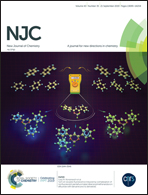Electrocatalytic hydrogen production using [FeFe]-hydrogenase mimics based on tetracene derivatives†
Abstract
The synthesis, structure, physical properties, and electrocatalytic hydrogen production of tetrathiatetracene ligand based [FeFe]-hydrogenase mimic molecules were investigated. By adjusting the amount of iron, mono- and bis-[FeFe] coordinated complexes 1 and 2 were synthesized. The structures of 1 and 2 were analysed by NMR, IR, and absorption spectroscopies, and cyclic voltammetry and DFT computational analysis. In the DFT electron density maps, the HOMOs and LUMOs were located at tetrathiatetracene units, indicating that these complexes retain mainly acene characteristics. When weak acid Et3NHBF4 was added to CH2Cl2 solutions of 1 or 2, the reduction potential of iron complexes was shifted to more positive values proportional to the concentration of acid. As the acid concentration increased, the current of the reduction wave also increased, indicating the occurrence of a catalytic proton reduction reaction. The bulk electrolysis reaction showed 65.8 TON for 1 and 52.8 TON for 2.
![Graphical abstract: Electrocatalytic hydrogen production using [FeFe]-hydrogenase mimics based on tetracene derivatives](/en/Image/Get?imageInfo.ImageType=GA&imageInfo.ImageIdentifier.ManuscriptID=C9NJ02790D&imageInfo.ImageIdentifier.Year=2019)


 Please wait while we load your content...
Please wait while we load your content...
